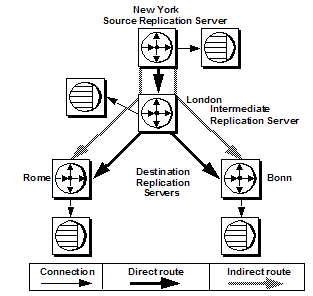To connect data servers and Replication Servers at the sites on a LAN or WAN, the replication system administrator at each site defines connections and routes.
Organizing connections and routes is fundamental in planning replication. The connections and routes you establish determine the number of Replication Server components you need. In addition, how you map replication between source and destination databases can impact system performance and data availability.
To specify where data is copied requires that you create the following paths or message streams between Replication Servers and between Replication Servers and databases in the system:
A connection from a Replication Server to a database
Replication Servers distribute transactions received from primary databases through connections to the replicate databases they manage. A Replication Server may have connections to several databases, but each database can have only one connection from a Replication Server.
Warm standby applications also use a logical connection, which represents both a database and its standby database.
A route from a Replication Server to another Replication Server
From each source Replication Server that manages databases containing primary data, you must specify a route to each destination Replication Server that subscribes to the data.
You can specify a direct route from a source Replication Server to a destination Replication Server, or an indirect route, with intermediate Replication Servers between the source and destination Replication Servers.
Figure 2-2 depicts an enterprise with several locations in Europe. A New York Replication Server routes all information for Europe through the London Replication Server. This arrangement reduces the number of direct connections the New York Replication Server makes and reduces WAN traffic. Data is sent once from New York to London, rather than from New York to each European location. The London Replication Server distributes the replicated data to the other European locations.
Refer to the Replication Server Design Guide for details and rules on designing routes and connections for a replication system.
See Chapter 6, “Managing Routes” and Chapter 7, “Managing Database Connections” for guidelines and procedures on when and how to create routes and connections.
See Chapter 3, “Managing Warm Standby Applications” in the Replication Server Administration Guide Volume 2 for more information about logical connections.
Figure 2-2: Routes and connections
